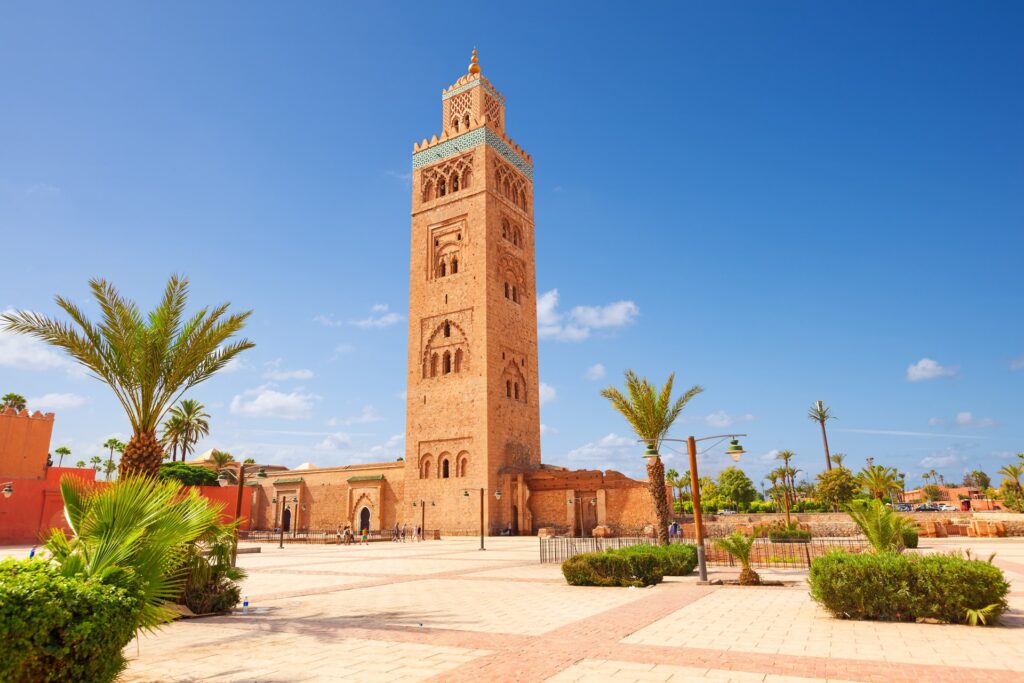Morocco, officially known as the Kingdom of Morocco, is a country located in the Maghreb region of North Africa. It is characterized by a diverse landscape that includes the Atlas Mountains, the Sahara Desert, and a long coastline along the Atlantic Ocean and the Mediterranean Sea. Morocco shares borders with Algeria to the east, the disputed territory of Western Sahara to the south, and the Atlantic Ocean and the Mediterranean Sea to the west and north, respectively. The best popular tourist destinations in Morocco 2024

Morocco has a rich and diverse cultural heritage influenced by Arab, Berber, and French civilizations. The country has a long history, with notable periods such as the Islamic Golden Age and the Berber dynasties.
Official Languages:
Arabic and Berber are the official languages of Morocco. French is widely used in government, business, and education.
Morocco is a popular tourist destination, attracting visitors with its vibrant markets, historic cities, and scenic landscapes. Cities like Marrakech, Fes, and Chefchaouen are known for their unique charm and cultural significance.
Moroccan cuisine is renowned for its flavorful and aromatic dishes. Traditional meals often include couscous, tagines, and a variety of spices, reflecting the country’s diverse culinary influences.
The best popular tourist destinations in Morocco 2024
Morocco is a captivating tourist destination, offering a diverse range of attractions that include historic cities, stunning landscapes, and a rich cultural heritage. Here are some of the popular tourist destinations in Morocco:
- Marrakech: Marrakech is a vibrant and culturally rich city located in the western part of Morocco, North Africa. It is one of the country’s major cities and a popular tourist destination, known for its historical significance, stunning architecture, vibrant markets, and unique blend of traditional and modern influences. Explore the historic medina, visit the iconic Koutoubia Mosque, and experience the lively atmosphere of Jemaa el-Fna square. Don’t miss the beautiful Jardin Majorelle and the Bahia Palace.
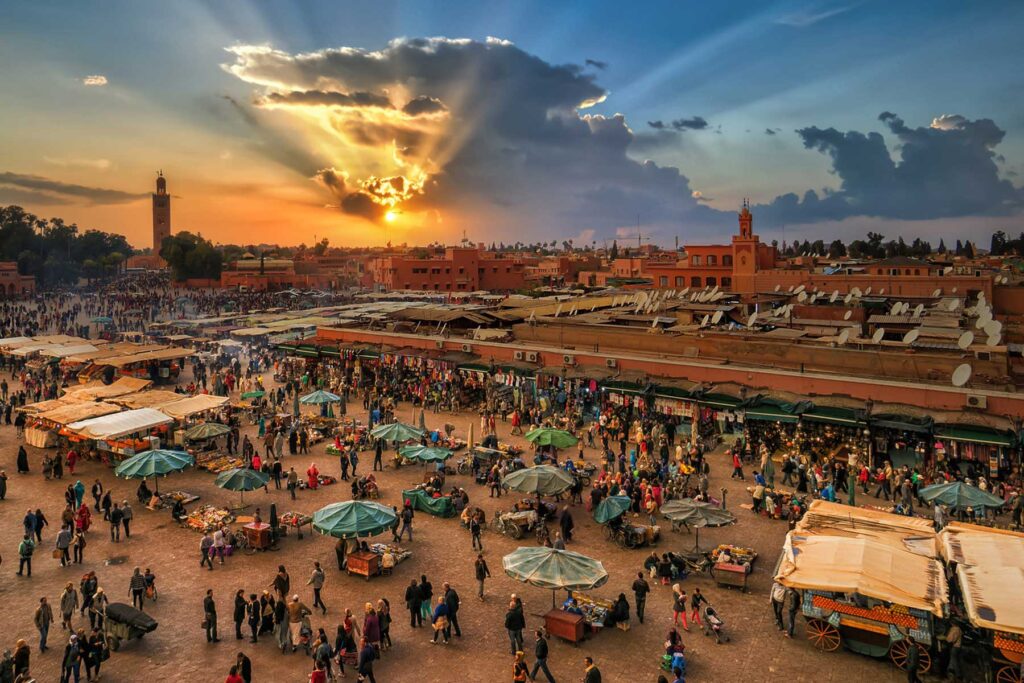
Fes:
Fes, also spelled Fez, is a prominent city in Morocco celebrated for its rich history, cultural heritage, and well-preserved medieval architecture. Key features include the UNESCO World Heritage Site of the Medina, a vast urban pedestrian zone renowned for its labyrinthine streets and traditional markets. The University of Al Quaraouiyine, founded in 859, stands as the world’s oldest continuously operating educational institution. Notable landmarks like the Bou Inania Madrasa and the Chouara Tannery showcase stunning Marinid architecture and traditional craftsmanship. The Blue Gate (Bab Bou Jeloud), Attarine Madrasa, and the Merenid Tombs contribute to the city’s historical charm. Fes is also home to various museums, including the Dar Batha Museum and the Nejjarine Museum of Wooden Arts and Crafts. The city is distinguished for its cuisine, featuring dishes like bissara, harira, and pastilla, and is renowned for its craftsmanship in zellige tilework, pottery, and metalwork. Overall, Fes offers a unique opportunity to immerse oneself in the medieval ambiance, cultural traditions, and artistic heritage of Morocco.

Chefchaouen:
Chefchaouen, often called the “Blue Pearl” or “Blue City,” is a captivating town nestled in the Rif Mountains of northwest Morocco. Notable for its blue-painted buildings, the town’s charm is rooted in the tradition introduced by the Jewish community. The labyrinthine medina features narrow blue alleyways, shops, and cafes, while the 15th-century kasbah and its museum offer cultural insights. The Grand Mosque reflects Andalusian architectural influences, and the serene Ras El Ma area, adorned with waterfalls, adds to the town’s natural allure. The Spanish Mosque on a nearby hill provides panoramic views and stunning sunsets. Chefchaouen is celebrated for its handicrafts, local markets, and the opportunity to explore the surrounding Rif Mountains through hiking trails. The town’s cuisine, echoing Moroccan flavors, and its relaxed atmosphere make Chefchaouen a sought-after destination, offering a unique blend of visual splendor and tranquility.
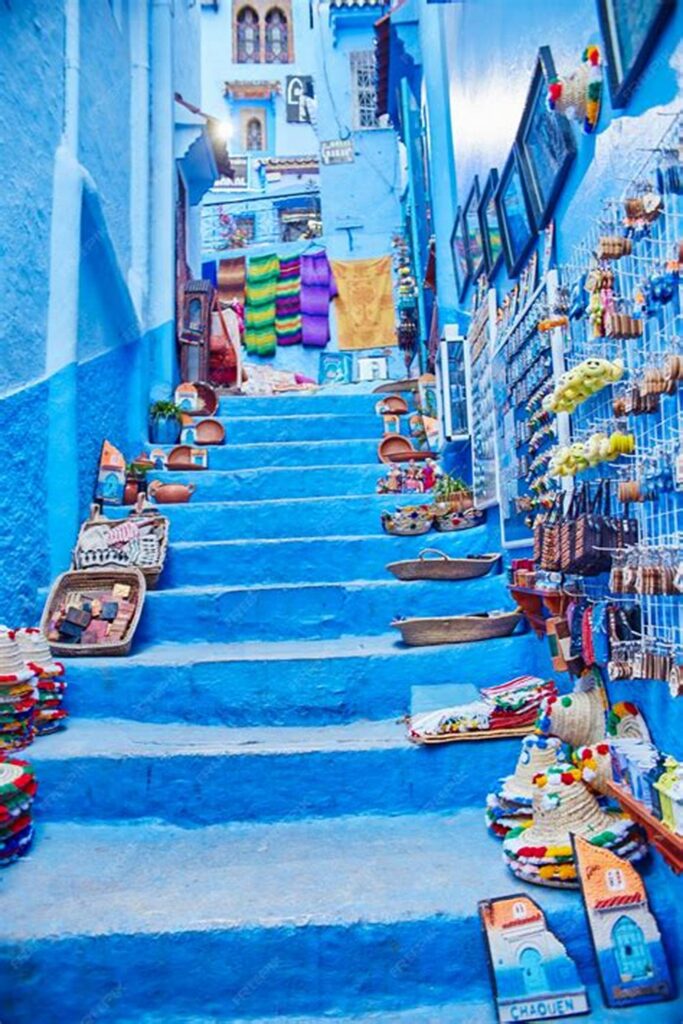
Casablanca:
Casablanca, Morocco’s largest city and economic hub, features notable landmarks and a dynamic atmosphere. The Hassan II Mosque stands as a major global landmark with intricate tilework and a stunning coastal location. The Corniche, a picturesque waterfront, offers a pleasant escape with its lined restaurants and shops. While its Old Medina is not as extensive, it showcases local crafts and traditional architecture. Mohammed V Square is a bustling central hub surrounded by administrative buildings, and the city is known for its Art Deco architecture from the French colonial era. The Central Market provides a vibrant glimpse into daily life, and cultural spaces like Villa des Arts and the Museum of Moroccan Judaism celebrate art and heritage. Casablanca’s diverse shopping and dining scene includes traditional souks and modern malls. As a vital financial center, it hosts major international companies and the Casablanca Stock Exchange. While lacking the historic charm of some Moroccan cities, Casablanca offers a unique blend of modernity, cultural richness, and economic significance, inviting visitors to explore its architectural diversity and vibrant urban atmosphere.

Essaouira:
Essaouira, a captivating coastal city in Morocco, is characterized by its UNESCO-listed medina with blue and white-washed buildings, offering a charming atmosphere and a variety of local crafts. The city features the scenic Skala de la Ville fortification, providing panoramic views of the Atlantic Ocean, and a lively port where visitors can witness the bustling fishing industry and savor fresh seafood. Essaouira’s long sandy beach is a hotspot for windsurfing and kiteboarding, attracting water sports enthusiasts. The bustling Moulay Hassan Square, surrounded by cafes and shops, is a central hub for experiencing local life and street performances. The city is enclosed by impressive ramparts offering scenic walks and views. Essaouira hosts the Gnaoua World Music Festival, showcasing its vibrant arts scene. Known for intricate thuya woodwork, the local markets offer handcrafted items. The historic Jewish quarter reflects the city’s diverse cultural heritage. Essaouira’s relaxed and bohemian atmosphere makes it a favored destination for artists, musicians, and those seeking a laid-back coastal experience, combining historical charm, artistic vibrancy, and coastal beauty.
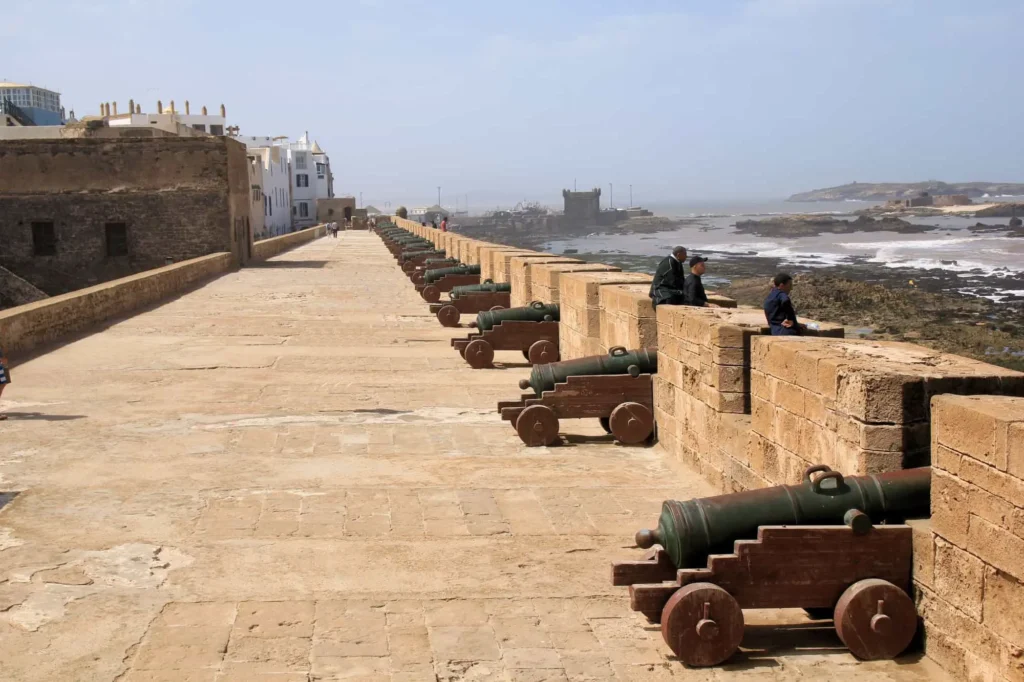
Atlas Mountains:
The Atlas Mountains in Morocco form a vast range spanning over 2,500 kilometers and are divided into the High Atlas, Middle Atlas, and Anti-Atlas. The High Atlas, with peaks over 4,000 meters, features dramatic landscapes and traditional Berber villages, including Mount Toubkal, North Africa’s highest peak. The Middle Atlas, known for cedar forests, has a more temperate climate, while the Anti-Atlas, in the southwest, boasts arid landscapes and deep gorges. Berber villages scattered throughout showcase the rich cultural heritage, offering insight into centuries-old traditions. The region is a popular destination for trekking, with Mount Toubkal drawing hiking enthusiasts worldwide. Lush oases, fertile valleys, and iconic gorges like Todra and Dades add to the picturesque landscapes. The Atlas Mountains are a melting pot of diverse cultures, where Berber communities preserve their unique traditions. The region is dotted with ancient kasbahs, such as the UNESCO-listed Kasbah of Ait Benhaddou, providing historical and cultural richness. Overall, the Atlas Mountains offer a captivating blend of breathtaking landscapes, cultural diversity, and outdoor adventures in Morocco.
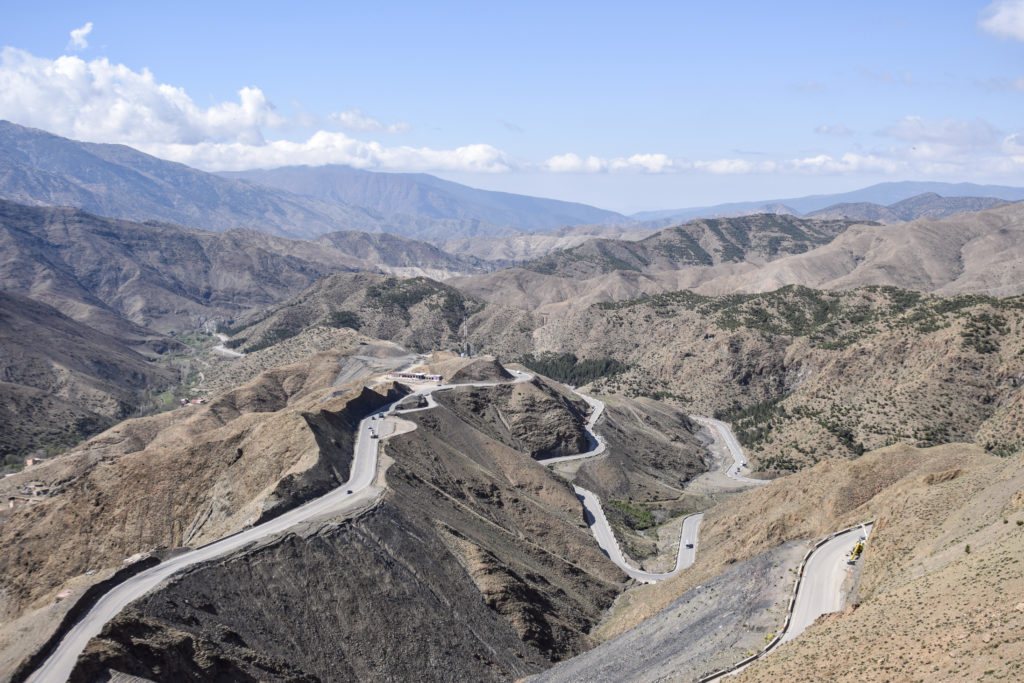
Sahara Desert:
The Sahara Desert in Morocco is a vast and mesmerizing expanse of arid terrain, spanning the southern region of the country. Key features include the renowned sand dune areas of Erg Chebbi and Erg Chigaga, offering distinct experiences in Merzouga and Zagora, respectively. Merzouga serves as a gateway, offering camel treks for visitors to explore the expansive desert and witness the enchanting colors of sunrise and sunset. Traditional Berber camps provide a unique overnight experience, complete with stargazing in the pristine desert sky. Fossil-rich areas like Erfoud showcase the Sahara’s geological history. While Todra and Dades Gorges offer a striking contrast, desert towns and oases, aside from Merzouga and Zagora, boast their own unique charm. The Sahara’s remote location provides unparalleled opportunities for stargazing, and cultural festivals celebrate the rich traditions of desert communities. Overall, the Moroccan Sahara offers a captivating blend of natural wonders, cultural richness, and adventure in one of the world’s most iconic landscapes.

Tangier:
Tangier, a vibrant city in northern Morocco, stands out for its rich history, multicultural ambiance, and strategic location at the entrance of the Strait of Gibraltar. The medina, perched on a hill, showcases traditional Moroccan charm, while the Kasbah offers panoramic views and historical sites. Tangier’s landmarks include the Grand Socco square and the American Legation Museum, symbolizing the city’s diplomatic significance. Natural wonders like the Caves of Hercules and the inviting Tangier Beach add to its allure. With picturesque gardens, a diverse culinary scene, and a unique multicultural atmosphere influenced by various communities, Tangier emerges as a captivating destination, inviting exploration of Morocco’s northern regions.

Ouarzazate:
Ouarzazate, often known as the “Gateway to the Sahara,” is a city in southern Morocco with distinctive features and attractions:
- Film Studios: Renowned for Atlas Studios and CLA Studios, Ouarzazate has earned the moniker “Morocco’s Hollywood,” being a favored location for international movie and TV productions.
- Kasbah Taourirt: A UNESCO World Heritage Site, this historic kasbah, once the dwelling of the Glaoui family, showcases intricate earthen architecture and a maze of rooms.
- Aït Benhaddou: Located nearby, this well-preserved ksar (fortified village) is another UNESCO site, famous for serving as a backdrop in numerous films and drawing tourists.
- Kasbah Tifoultoute: Offering panoramic views of the landscape and the Ounila River, this kasbah is a scenic attraction near Ouarzazate.
- Atlas Film Studio Tour: Visitors can explore film sets of famous productions, gaining insights into the filmmaking process.
- Taourirt Oasis: Oases surrounding Ouarzazate provide a lush contrast to the desert, featuring traditional irrigation systems known as khettaras.
- Museum of Cinema: Showcasing the region’s filmmaking history, this museum exhibits costumes, props, and memorabilia from movies shot in the area.
- Tifoultoute Valley: Offering picturesque scenery with greenery, palm groves, and traditional Berber villages, it’s an ideal destination for a peaceful retreat.
- Rose Valley: Known for its annual rose festival and cultivation of Damascus roses, the valley contributes to the production of rose water and cosmetic products.
- Dades Gorge: Although a bit distant, the Dades Gorge features a dramatic canyon with towering rock formations and a winding road, providing breathtaking views.
Ouarzazate serves as a central point for exploring the diverse landscapes of southern Morocco, encompassing deserts, historic kasbahs, lush valleys, and captivating gorges. Its strong connection to the film industry adds a unique and culturally rich dimension to its appeal.

Rabat:
Rabat, Morocco’s capital on the Atlantic Ocean, boasts a rich blend of history, culture, and modernity. The Kasbah of the Udayas, perched on a hill, showcases its historic citadel with picturesque streets and Andalusian gardens. The iconic Hassan Tower, part of an incomplete mosque, and the nearby mausoleum of Mohammed V stand as significant architectural landmarks. Chellah, an ancient necropolis, provides a serene escape, while the Royal Palace impresses with its grandeur. The bustling Medina offers an authentic Moroccan experience, distinct from more touristy medinas. The National Archaeological Museum houses artifacts spanning various eras. Mohammed V Avenue, lined with shops and cafes, is a central hub for strolling. The Andalusian Gardens and Rabat’s Atlantic beaches provide tranquil retreats, and Maarif Street reflects the city’s contemporary lifestyle. As the political and administrative hub, Rabat’s diverse landmarks make it a compelling destination for exploration.
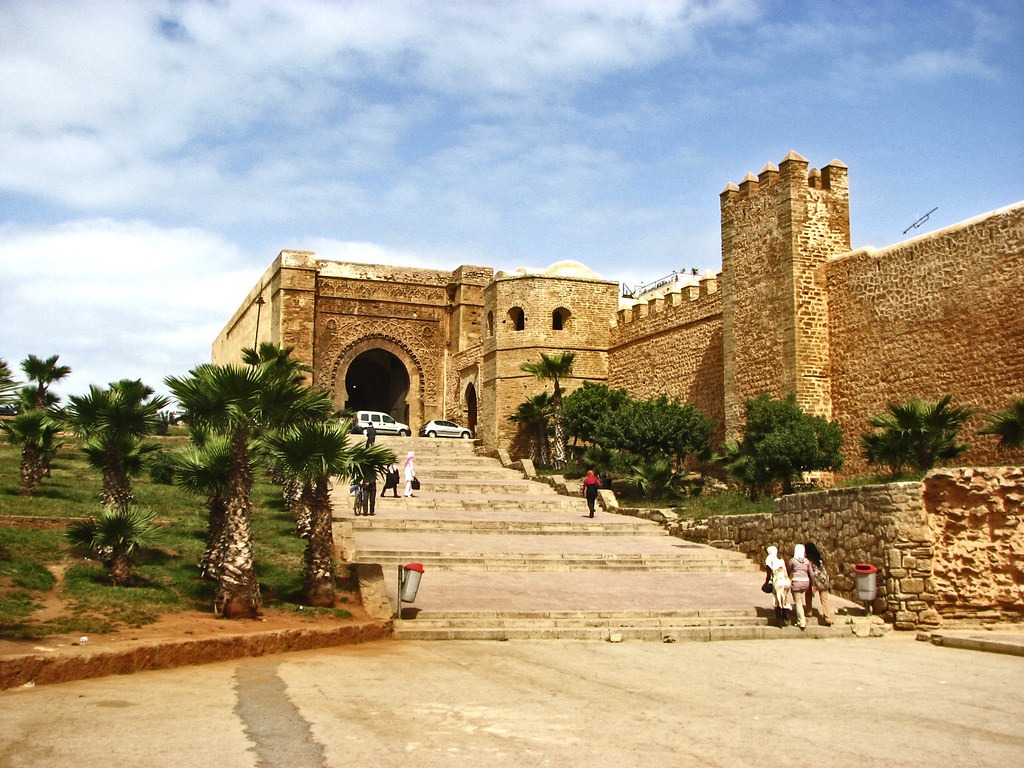
Agadir:
Agadir, a coastal city in southwestern Morocco, is celebrated for its stunning beaches, modern infrastructure, and laid-back ambiance. The extensive beachfront, with its sandy shores along the Atlantic Ocean, is a major draw for relaxation and water sports. The contemporary Agadir Marina offers a lively atmosphere with shops and restaurants. The Kasbah of Agadir Oufella provides historical charm and panoramic views, while Souk El Had showcases bustling Moroccan daily life. Other attractions include the Valley of the Birds, La Médina d’Agadir, the Amazighe Heritage Museum, and the educational Crocoparc. Dayet Ifrah, a tranquil freshwater lake, and golf courses with ocean views add to the city’s appeal. Agadir’s blend of modern amenities, cultural experiences, and beach attractions positions it as a prominent destination in Morocco. The city’s development since the 1960 earthquake has transformed it into a key coastal hub.

More option:

